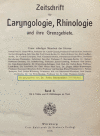Where do we come from? Where are we? Where are we going? : President's speech at the 92nd Annual Meeting of the German Society of Otorhinolaryngology, Head and Neck Surgery on the occasion of its centennial
- PMID: 35648169
- PMCID: PMC9157482
- DOI: 10.1007/s00106-021-01137-7
Where do we come from? Where are we? Where are we going? : President's speech at the 92nd Annual Meeting of the German Society of Otorhinolaryngology, Head and Neck Surgery on the occasion of its centennial
Conflict of interest statement
S.K. Plontke declares that he has no competing interests.
Figures













Similar articles
-
[Where do we come from? Where are we? Where are we going? : President's speech at the 92nd Annual Meeting of the German Society of Otorhinolaryngology, Head and Neck Surgery on the occasion of its centennial. German version].HNO. 2022 Jul;70(7):508-519. doi: 10.1007/s00106-021-01136-8. Epub 2022 Mar 22. HNO. 2022. PMID: 35318497 Free PMC article. Review. German. No abstract available.
-
[Annual meeting of the German Society of Otorhinolaryngology, Head- And Neck Surgery].Laryngorhinootologie. 1993 Oct;72(10):492. doi: 10.1055/s-2007-997942. Laryngorhinootologie. 1993. PMID: 8267825 German. No abstract available.
-
[Reports from the annual meeting of the German Society of Otorhinolaryngology, Head and Neck Surgery in Berlin].HNO. 2000 Dec;48(12):877-8. doi: 10.1007/s001060050683. HNO. 2000. PMID: 11196088 German. No abstract available.
-
[Reports from the annual meeting of the German Society of Otorhinolaryngology, Head and Neck Surgery in Berlin].HNO. 2000 Aug;48(8):560-1. doi: 10.1007/s001060050616. HNO. 2000. PMID: 10994165 German. No abstract available.
-
[On the international networking of the German Society of Otorhinolaryngology, Head and Neck Surgery].HNO. 2021 May;69(5):416-421. doi: 10.1007/s00106-021-01013-4. Epub 2021 Mar 17. HNO. 2021. PMID: 33730247 Free PMC article. Review. German.
References
-
- Anonymous. Deutsche Gesellschaft für Hals-Nasen-Ohren-Heilkunde, Kopf- und Hals-Chirurgie . Geschichte der akademischen Lehrstätten, Lehrer und Lehrerinnen und Kliniken der Hals-Nasen-Ohren-Heilkunde, Kopf- und Hals-Chirurgie in Deutschland. Heidelberg: Springer; 2022.
-
- Antes G, Thielscher C. Der Arzt behält die Deutungshoheit trotz KI. Dtsch Arztebl. 2019;116:A18–A19.
-
- Bloch E. Das Prinzip Hoffnung. Berlin: Suhrkamp; 1959.
Publication types
MeSH terms
LinkOut - more resources
Full Text Sources

